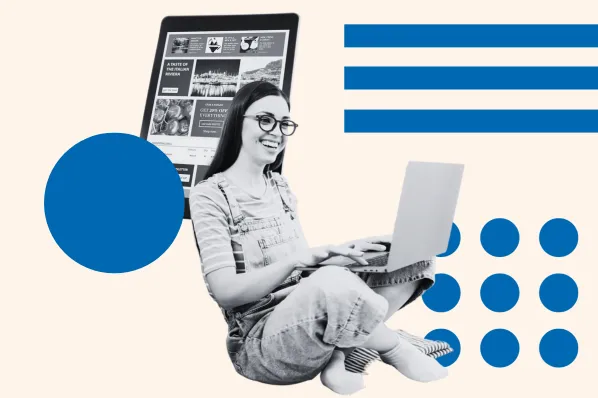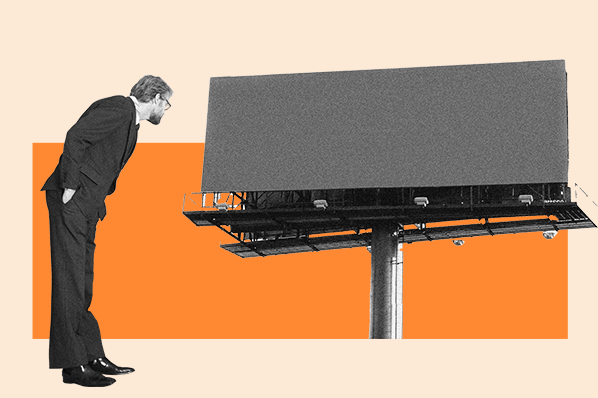As a content growth and innovation leader for HubSpot, I know how important it is to find impactful ways to expand your brand’s reach. In my experience, one of the more effective and underrated channels for marketers is podcast advertising.

Outside of work, I’m an avid podcast listener. I’ve been persuaded to test out a new product recommended by my favorite hosts. That’s especially true if I’ve been listening to a show for years. There’s a degree of parasocial trust that pushes me over the edge.
So podcast advertising can be effective, but knowing where to start with podcast advertising can be confusing. To help, I’ve gathered my personal experiences and insider tips from HubSpot’s podcasting team into this comprehensive guide of everything you need to know about podcast advertising.

Table of Contents
- How does podcast advertising work?
- Benefits of Podcast Advertising
- Podcast Advertising Terminology
- Types of Podcast Ads
- How to Advertise on Podcasts
- My Top 12 Tips For Successful Podcast Advertising
How does podcast advertising work?
I think of podcast advertising as similar to other forms of advertising. First, I identify podcasts that fit my target audience and demographics and negotiate a deal. From there, my team creates the ad content, and the host inserts it into the episode.
Podcast ads usually describe the featured product or service and often include the host's personal experience. Many ads also include promo code-based discounts for listeners. When I think of examples in my life, Blue Apron comes to mind. I heard their ads dozens of times on my favorite NPR podcasts with a nice discount if I use their code.
The host experience is one of the biggest differences in podcast advertising. My ads might be recorded audio or a script the host reads and inserts their experience into to add social proof.
You can also use self-service advertising tools like Spotify’s Ad Studio, which helps produce and launch podcast ads targeted to the right audience on its streaming platform across multiple shows at once. Once an ad is published, teams use metrics such as listens, downloads, and conversions to track ad performance.
.png)
Free Advertising Planning Kit
Plan and launch an effective and profitable advertising campaign with this guide and set of templates.
-
An Overview of Popular Advertising Methods
-
The Pros, Cons, and Costs of Advertising Types
-
A Planning Template to Outline Timeline, Budget, and Goals
-
A Project Pitch Presentation Deck to Share With Stakeholders
Benefits of Podcast Advertising
I’ve found that podcasts are rarely the first marketing channel marketers think of, but they’re one of my favorites. Let’s go through my top reasons for using podcast advertising in my marketing strategy.

Increased Brand Awareness
Podcasts represent a huge potential audience and have become an increasingly popular part of consumer’s lives. According to Edison Research, 98 million people listen to podcasts weekly.
More people than ever are engaging with podcasts during their daily routines — like driving to work, working out, and cleaning around the house — making podcasts an excellent medium for advertising.
Targeted Audience
I find that podcasts are beneficial for accessing niche audiences. For example, the demographics of true crime podcasts are primarily younger women. Many successful shows create very specific niches to reach their ideal listeners and build a community of individuals with particular interests and behaviors.
Higher Engagement
As a marketer and a regular human being, I know advertisements can be an unwelcome interruption. Balancing that reality with reaching more of my target audience can be tricky. Podcasts help solve that problem.
Most podcast listeners understand that advertising funds their favorite podcast shows and see podcast advertising as supporting small creators. As a result, 46% of listeners don’t find podcast advertising intrusive.
Increased Credibility
In my experience, long-form content helps build trust. Unlike influencers who leverage short-form content like TikTok videos, podcast hosts hold their audience’s attention for an hour or more.
That extra time allows them to build solid relationships and provide me with improved brand perception by association when I advertise with them. It’s a form of social proof.
Podcasts provide a unique selling point for advertisers. Audiences are often connected with the host on an emotional level. That means that when the host reads my ad copy, the listeners are already predisposed to trust the message. It's a bit like an endorsement from a celebrity or trusted friend.
Case in point, I love to listen to The Splendid Table from America Public Media. When the host, Francis Lam, makes a recommendation about a cooking product or technique, I take note.
Measurable Results
With 43% of advertisers worried about measuring the effectiveness of marketing campaigns, we need data. One of my favorite podcast ad benefits is the ability to see how many people listened while the ad was running and use unique links to attribute clicks and conversions to each episode.
Podcast Advertising Terminology
When I first jumped into the world of podcast advertising, there was jargon I had no idea about. So, before you dip your toes in, I want to share some terms I wish I had known sooner. Let’s explore that vocabulary.
- CPM rate — "cost per mille,” the flat standard cost advertisers pay for every 1,000 impressions of an ad.
- Host-read ad — an ad voiced by the host of a podcast.
- Dynamic ad insertion — a self-service advertising method offered by many streaming services that uses software to insert a pre-recorded ad into podcast audio automatically.
- Contextual targeting — a dynamic ad placement method using software and contextual data to match the listener’s mood or actions. For example, ads for mental health services are placed on a relationship or self-care podcast.
- Programmatic ad — pre-recorded ads voiced by someone other than the host, such as an announcer or voice actor. These ads are often placed in multiple shows with dynamic insertion.
- Ad placements — when an ad takes place during the podcast episode. Pre-Roll Ads play before the podcast starts, Mid-Roll Ads are in the middle like an intermission, and Post-Roll Ads play after the episode ends.
- Live-read ad — an ad performed live by the host during a podcast episode instead of being scripted and pre-recorded.
- CTA — “call to action,” which is the hook of the ad, the action you want the listener to take. Most include URLs or promotional codes used to track the ad’s performance.
- Downloads — the number of times listeners have downloaded a podcast episode. This is the most common metric used to determine the show's potential reach.
Types of Podcast Ads
In addition to knowing industry terms, I find it helpful to understand how different types of ads work. Here are the ones I’ve found most effective, along with examples of each.

Native Ad
Native ads are created by the advertiser and integrate seamlessly into the content of the episode. I like to use these for top-of-funnel campaigns and when I’m working with self-service streaming placements.
Typically, these short audio or voiceover clips run for 15 to 60 seconds and describe a product, service, or promotion you want to feature. They’re often placed as pre-roll or mid-roll ads and might be introduced by the host as “a word from our sponsor.”
Toyota created an ad for the RAV4 with a narrator describing several vehicle features but didn’t use the podcast name in the sponsorship message. By only saying, “This episode is brought to you by,” the ad can be used on many different podcasts.
Sponsored Content
Sponsored content (also called branded segments) is a lot like a verbal version of a blog post and can even be a complete podcast episode. Topics need to be relevant to the podcast and my company or industry, so I work with the podcast's staff to brainstorm and create content that works for everyone.
While it’s more involved than native ads, I like to use these when a podcast overlaps heavily with my target audience because this can become an ongoing multi-season relationship.
The content doesn’t have to mention your product or brand directly, but the hosts will at least note who sponsored the episode and include a brief blurb about it.
One example is the Fresh Invest show created by Morning Brew Podcasts and sponsored by Fidelity. The host breaks down the investing environment and provides listeners with solid advice and actionable tips. As the sponsor, Fidelity receives brand mentions with the right target audience and (most importantly) at the right time — when the audience’s interest in investing is high.
Paid Interview
This type of sponsored content directly involves me or another expert in my company. We pay the podcast to interview an expert we chose on a topic we select.
This gives our company experts a great opportunity to spread brand awareness and showcase their expertise. In turn, the podcast gets sponsorship money, a credibility boost, and interesting interview content about a topic related to its own mission.
To me, it’s a powerful blend of advertising, brand building, and thought leadership.
In this episode of Freakonomics Radio, host Stephen J. Dubner interviews Microsoft CEO Satya Nadella about the possibilities and risks of AI. Nadella provides his insights for the audience, placing Microsoft at the forefront of the AI discussion for listeners.
I find that the paid interview approach can be quite valuable when you’re using a demand generation strategy. These interviews give your leadership time to provide much-needed context and explain why there’s an urgent need for the product that the market might not already understand.
Product Placement
We‘ve all seen brand placements on TV and in movies. For example, the actors drive a specific brand of car and mention features as part of the script. That’s product placement, and you can do it in a podcast, too. The hosts will casually mention your product as part of the discussion.
Totinos was placed centrally in a “My Brother, My Brother, and Me” podcast. While Totinos were constantly discussed, they still didn’t come across as too salesy or aggressive to listeners.
The hosts snacked on Totino’s pizza rolls while playing games revolving around food and having random discussions about life.
Direct Response Ad
Direct response ads are a type of native ad that combines product placement. The podcast host reads your script but then adds a call to action, like clicking a link on the podcast homepage or using a coupon code.
I like using these ad spots because they are host-read and can benefit from the listener feeling like they are getting a solid recommendation from the host.
On this episode of Julia Louis-Drayfus’s podcast, “Wiser Than Me,” you can hear multiple direct-response ads at the 27:00 minute mark featuring brands like Hairstory and BetterHelp.
Both of these ads include show-specific discount codes that listeners can use to receive a discount when they try the brand’s products and services.
Now that you‘re familiar with the types of podcast ads available to you, let’s discuss how I find and sponsor podcasts.
How to Advertise on Podcasts
Whenever I have a new campaign to plan, I follow these steps to help ensure a successful podcast advertising campaign.

Step 1. Determine the type of ad you want to run.
There are several ad formats to consider, and the best option for you depends mostly on your budget and goals. To determine what type of ad to run, I look at budget, goal, and timeline.
Budget
Not every ad can be a long-form production. I need to match my available budget to the type of ad that will give me the best return within that number. Host-read ads and sponsored content can get expensive quickly.
For a small budget, I recommend starting with programmatic native ads. Those are ads you produce and upload to a library for placement into podcast episodes through self-service software in a streaming tool like Spotify Ad Studio.
These are less costly, and streaming services have greatly improved their use of contextual data to find more relevant placements for your ads. These ads also work best for me when my goal is more centered on generating brand awareness than conversions or when I don’t have a specific target podcast in mind.
Goal
What I’m trying to accomplish with my ad is critical to my decision-making. If I want to build brand awareness, sponsored content or a paid interview work well. However, if I need direct action from the audience, a direct-response ad is usually a better choice.
Timeline
How quickly an ad needs to run is a big part of my decision process. Sponsored content takes a lot longer to produce than a host-read ad. Likewise, arranging schedules for a paid interview can take significant time. Even native ads can be time-consuming with voice actors and post-production work.
I need to balance the combination of time I have with my budget and goals to create the best outcome.
.png)
Free Advertising Planning Kit
Plan and launch an effective and profitable advertising campaign with this guide and set of templates.
-
An Overview of Popular Advertising Methods
-
The Pros, Cons, and Costs of Advertising Types
-
A Planning Template to Outline Timeline, Budget, and Goals
-
A Project Pitch Presentation Deck to Share With Stakeholders
Step 2. Select the best ad placement for your campaign.
Next, consider your ad placement, which can impact your budget and ROI.
Overall, I’ve found that more people listen to the first few minutes of a podcast, but pre-roll ads have a lower CPM rate because they’re easy to skip. As such, these work well for top-of-funnel campaigns and building brand awareness.
On the other hand, I find that mid-roll ad placements (ads in the middle of the episode) have a higher CPM as they reach a more engaged audience who are likely to follow a CTA. I choose mid-roll placements if I’m trying to drive website visits, purchases, or free trial sign-ups.
Step 3. Write your script.
Now that I’ve determined what type of ad to run and determined the placement, it’s time to tackle the messaging. Even if I’m doing host-read ads, the on-air talent needs talking points from me to stay on point with my goals for the campaign.
Here are the elements I include when writing podcast ad scripts.
Length
While 30- or 60-second ads may feel standard, it’s important to tailor the length to fit the message, ad type, and budget.
Average CPM Rates
- 30-second ad placement. $18.
- 60-second ad placement. $25.
Once again, I consider my overall campaign objective here. If I’m simply wanting to get my brand’s name out there, then shorter ads can get the job done. However, if I want the listener to carefully consider my product and take action, then I would choose a longer ad so I could write a script that covers their pain points and the value my company offers.
Directions for Voice Actors
No matter how perfect my script copy is, I need to make sure I have the right people reading it and that those folks have instructions about what I want. Voice actors need direction just like live-action actors do.
The two big points I always share are tone and voice description. I include details about the emotions and style of the copy for the voice actor. Examples of tone include bright, cheerful, serious, urgent, or friendly.
I also need to make sure we hire the right voice actor. A voice description helps your staff pick the right person. While voiceover actors often have different “characters” they can create when reading your ads, we still need to ensure that the person chosen can meet gender and age styles, such as a female-sounding millennial voice.
Hook
Every script needs an attention-grabbing statement that resonates with my audience and keeps them from fast-forwarding through the ad. I find asking questions or describing the listener’s pain points to be effective.
Personal Story
Using a personal story about how my product solves the listener’s problem helps make a connection. Humor, education, and emotion are the top three storytelling tools I use when writing scripts.
I recommend choosing your method based on what fits your brand, product, and campaign. For example, if I’m advertising a medication, I might take the emotional and empathetic approach, whereas humor could work better for products like snacks or entertainment.
Call-to-Action
A call-to-action (CTA) tells the listener what action to take next, like visiting my website or signing up for a free trial. I like to create unique URLs or offer codes for podcast CTAs because they encourage action and help me track the results of each campaign.
Step 4. Record and finalize the ad.
Once the script has been finalized, it has to be recorded.
For host-reads, you just need to get the script to the podcast host. But if you will be recording the ad, you’ll select your voiceover actors, arrange for recording and post-production work, and ship the ad to the host or streaming service.
Depending on your company, you may have an in-house production team that handles all of those details for you. If you’re a small shop or solo entrepreneur, you’ll need to manage those details yourself.
Streaming platforms like Spotify have their own tools to help record native ads. However, if you record the script yourself, you’ll need a quiet place and a reasonable microphone. To hire a voice actor on a budget, check out platforms like Casting Call Club, where new voice actors are willing to work for a small fee or no cost because they need credits to add to their resumes.
Ask your voice talent to provide a WAV file, as that is the most commonly used format for native ad production.
Post-production combines voice, properly licensed music, and sound effects to create a finished ad that matches the exact time needed and meets the audio specifications, such as stereo or mono, the bit rate, and doesn’t have any unwanted background noise.
I usually use an audio producer for this, but it can be DIY’d for more straightforward ads using tools like Adobe Audition or Audacity.
Once you upload the audio file to the streaming service or podcast host, the ad will be placed in a podcast episode or multiple episodes by the host or the streaming service's dynamic insertion technology.
My Top 12 Tips for Successful Podcast Advertising
- Understand podcast demographics.
- Get familiar with podcast advertising prices.
- Choose shows related to your industry or brand.
- Leverage competitor analysis in your research.
- Don’t ignore smaller shows.
- Advertise with multiple shows at the same time.
- Research download numbers.
- Look at each show’s back catalog space.
- Consider video podcasts.
- Buy spots through self-service.
- Build relationships with hosts and producers.
- Track performance and calculate ROI.
1. Understand podcast demographics.
I find that podcast demographics don't change drastically from show to show; they’re more of a fine-tuning of a larger audience.
According to HubSpot's former corporate marketing manager, Sam Balter, the overall podcast audience is mostly made up of "affluent, educated millennials“ and is a ”good audience for brands pretty much regardless of what show you’re on."
Most podcast listeners are old enough to make purchasing decisions and have enough income to make those purchases.
Alanah Joseph, head of creator partnerships, talks about how important understanding the show's listeners is for successful ad campaigns.
"We’re looking at the ad from the point of view of a listener. Does the ad feel like it’s an authentic part of the show? Is it enjoyable to listen to?” Joseph postulates.
The more ads match the content of the show, the more likely listeners will stay engaged.
2. Get familiar with podcast advertising prices.
Figuring out podcast advertising pricing can be confusing at first. There are huge differences in pricing, and prices don’t always reflect the show's desirability.
In my experience, though, podcast advertising tends to be more transparent than you might think. Most podcasters and podcast networks use the same standardized formula to calculate advertising costs.
To get a rough idea of ad costs for a specific show before reaching out to a podcast team or network, I like to look at the show’s previous episodes and plug that data into this formula.

Using CPM breaks numbers down into easier-to-digest chunks per thousand listeners so you can more easily compare numbers. On average, Balter says most podcast ad rates tend to run between $10 and $50 CPM, making it relatively affordable for even small brands, although very popular podcasts will cost more.
That means a podcast with 10,000 downloads would charge around $100 to $500 for an ad placement.
However, when I’m running more intensive promotions, like a fully sponsored podcast episode, I find formulas aren’t accurate. Costs are much more variable for long-form advertising types.
3. Choose shows related to your industry or brand.
My best-performing ads relate to the podcast series or episode because listeners are more likely to remain engaged and respond to the CTA, especially if they identify with the pain points you solve. As a result, I always aim for relevance if I’m manually reaching out to shows instead of using a self-service streaming option.
For example, if I wanted to place an ad about a B2B recruiting service, I would look for a podcast that discusses human resources for B2B companies.
The same principle applies to B2C products. This episode of TASTE opens with an ad for Taste Europe’s French butter, highlighting its uses, benefits, and why it’s the choice of many professional chefs. The ad is a perfect fit for listeners who come to TASTE to get their fill of food and culture.
I look for shows where the host would use and love my product. If the host would love it, there’s a strong chance it will be a good fit with their audience.
4. Leverage competitor analysis in your research.
I like using competitive analysis to help me discover what the other guys are doing. By examining what brands similar to mine are trying, I can find opportunities to gain an advantage over competitors.
I’ve found that watching where my competitors advertise inspires me in my search and helps me narrow my focus by identifying the types of shows and topics that could work for me. That said, I’m not a fan of copying and pasting a competitor’s strategy. I prefer to use it to generate ideas and then challenge myself to figure out what I can do better.
5. Don’t ignore smaller shows.
When I first started in podcast advertising, I had to decide whether to spend my whole budget on one ad for a big show with promising numbers or to hedge my bets across multiple podcasts. I’ve found that Balter was spot on when he said, "It’s better to play an ad multiple times on a smaller show than try to play a single ad on a big show."
I have to pay much more for one or two ads on major podcasts with a huge listenership, and one or two ad plays are rarely memorable. While you might get great visibility, results are more of a gamble in my experience.
Without a decent ROI, you're wasting money. By spreading ad dollars across many repetitions, you help prevent an all-or-nothing situation.
I research several smaller podcasts with engaging content related to my product or industry. From there I like to invest a bit of my ad spend in each show and look at the numbers. If one or two of them don’t meet my expected ROI, I adjust my strategy and move my ad dollars to shows that give me more engagement and brand awareness.
.png)
Free Advertising Planning Kit
Plan and launch an effective and profitable advertising campaign with this guide and set of templates.
-
An Overview of Popular Advertising Methods
-
The Pros, Cons, and Costs of Advertising Types
-
A Planning Template to Outline Timeline, Budget, and Goals
-
A Project Pitch Presentation Deck to Share With Stakeholders
6. Advertise with multiple shows at the same time.
When I plan to invest in multiple podcasts — or place multiple ads in a single episode — I look for a network that produces multiple shows aligned with my product and build a relationship with that network, like Gimlet.
This type of agreement with one network is called a pulsing strategy, and Balter explains that "because people who listen to Gimlet shows are likely to listen to other Gimlet shows, you can get a solid number of impressions off of a few shows over a relatively short amount of time without inundating listeners with the same ad over and over again."
For example, this Hendrick's Gin ad was featured on multiple Gimlet podcasts and its advertising page.
It’s a simple native ad with a short “sponsored by Hendrick's Gin” comment before briefly describing the flavors in the gin and highlighting the brand’s value proposition.
The ad feels unique, but because it’s not industry-specific, it can target a wide audience, making it a good choice for placement on multiple shows on the same network with minor changes to the beginning of the ad.
7. Research download numbers.
I always take time to properly vet podcasts when comparing download and listen metrics.
Balter makes a great point when he warns that aggregate podcast downloads aren't always accurate or tracked properly, so you should always check individual episode download numbers.
Here are some strategies I use to verify a podcast’s numbers:
- Look at all the platforms that they post their podcasts on. If they post on a major website like SoundCloud or Spotify, you should be able to see platform-provided view numbers.
- Look for them on social media. While I don’t look for show numbers here, I do pay attention to follower counts and fan engagement activities that help me gauge how invested the audience is in the podcast.
- Work with a credible network. Podcast networks like Gimlet Media and Wondery vet shows before granting membership, and many have minimum download thresholds that must be bet before podcasts can sign up.
When I finally talk to the podcast producers, I make sure to get as much specific data as possible about views and impressions. I also like to ask if previous advertisers saw an ROI. If a podcaster can show proof that advertisers make money from ad spends with them, I’m more likely to sign up.
8. Look at each show’s back catalog space.
It's an odd-sounding term, but back catalog just means how many previous episodes of a podcast exist.
I love targeting these episodes because they’re often listened to and shared by the show’s audience, but because they aren’t first runs, there isn’t as much ad competition for them.
When I’m using this strategy, I look specifically for evergreen episodes that will continue to remain relevant for an extended time.
For example, if you're a marketer for an ecommerce home-shopping website, you could look for back catalog episodes of home decor podcasts.
9. Consider video podcasts.
While most people think of podcasts as audio-only, more shows are starting to record and post their podcasts' videos on YouTube. I find that this combination of long-form content and the ability to highlight my product and brand visually is a double-win for me.
In this example, Steven Bartlett, host of The Diary of a CEO Podcast, presented an ad for Huel Nutrition and simultaneously showed his viewers the products.
The brand also gets product placement throughout the interview, which is over an hour long.
In my experience, video podcast ads are helpful for brands with physical products and even software companies, where a host can show a screenshot of the platform’s features.
10. Buy spots through self-service.
With a complete audio clip for a standard ad slot, I like using tools like Spotify Ad Studio to quickly purchase space and target ads to appear on multiple podcasts.
I also love host-read ads using a service like Midroll. Instead of recording a native ad, I just submit ad information and purchase slots in multiple shows. It's fast and cost-effective.
11. Build relationships with hosts and producers.
When I’m working on placing more complex ads, in-person connections with hosts and show producers are helpful.
"By being intentional when looking for creators, we can create a truly collaborative environment and allow creators to infuse their personality and voice into our ads," says Joseph.
Once I’ve researched and selected a few podcasts, I reach out to discuss advertising options and ideas. My first contact might be an email that includes:
- A little bit about my brand.
- Why I think it's a good fit for the podcast.
- Questions about their growth and key success metrics.
Check out this template for a quick first-contact email idea.

I like this process because it’s collaborative, and the hosts seem to appreciate it. Many like getting involved in writing the script rather than reading something I’ve written verbatim.
Joseph adds, "I've learned the more we allow our podcasters to participate in the creation of the ad, the better the ad will be.”
12. Track performance and calculate ROI.
Regardless of what type of ad or ad placement I purchase, I always track the money I spend and the revenue generated by each campaign.
If I’m publishing on multiple podcasts, tracking revenue helps me decide which ones warrant more advertisements and which I might walk away from.
Need help calculating ROI on your ads? Here’s a post on a simple ROI formula you can use to get started.
Boosting Your Advertising Strategy with Podcast Sponsorships
I love finding neglected advertising outlets, and podcasts are full of opportunities. With a generally affluent audience and less ad competition, podcasting is ripe for advertising.
The right podcast advertising strategy delivers your message to an engaged audience at lower costs and higher ROI than many other channels. Podcasting advertising is a great way to gain brand awareness.


![9 Advertising Trends to Watch in 2024 [New Data + Expert Insights]](https://blog.hubspot.com/hubfs/advertising%20trend.png)




![How to Make an Ad: A 15-Step Guide [+Expert Tips]](https://blog.hubspot.com/hubfs/how%20to%20make%20an%20ad.png)

![How Consumers Responded to Black Friday in 2022 [+ Holiday Marketing Tips]](https://blog.hubspot.com/hubfs/black-friday-ads_0.webp)
![What is Comparative Advertising? [+ Examples]](https://blog.hubspot.com/hubfs/Untitled%20design-Aug-17-2022-02-39-51-39-PM.png)